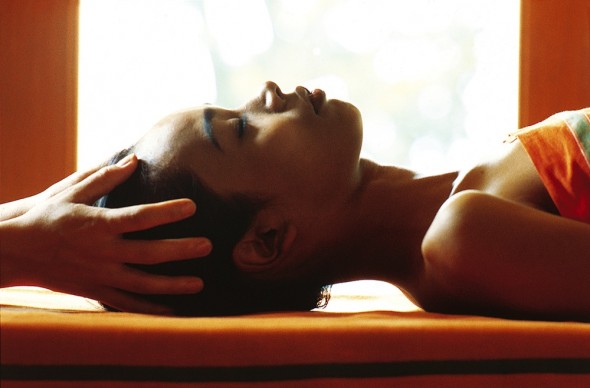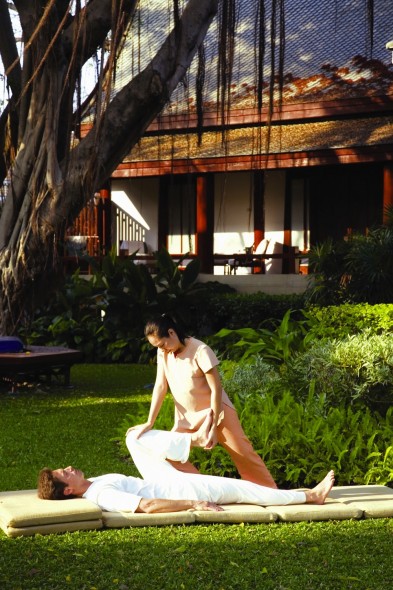
Ananda in the Himalayas
The health of the wellness travel industry may be just warming up, according to a new study released by the Global Spa & Wellness Summit (GSWS). Predictions hold that spa- and wellness-focused trips will reach $678.5 billion in worldwide expenditures by 2017, accounting for some 16 percent of projected total tourism revenues.
The study, released last month by SRI International and GSWS, an industry education and research organization, was the first to benchmark and analyze this fast-emerging tourism segment.
 “This new research clearly reveals more people are now choosing destinations that help them keep or get healthy while traveling, while a smaller (and also growing) segment are also now taking trips with the specific, sole purpose of improving their personal well-being,” says Ophelia Yeung, lead author of the study and co-director, Center for Science, Technology & Economic Development at SRI.
“This new research clearly reveals more people are now choosing destinations that help them keep or get healthy while traveling, while a smaller (and also growing) segment are also now taking trips with the specific, sole purpose of improving their personal well-being,” says Ophelia Yeung, lead author of the study and co-director, Center for Science, Technology & Economic Development at SRI.
JoAnn Kurtz-Ahlers, a leading name in wellness travel marketing and consulting for luxury resorts and spas, agrees.
“We have been seeing a sharp rise in the number of travelers who are seeking vacations that not only get them away from their busy lives to relax and retool, but actively help to get them back on track and to feel better overall. Many of the hotels and spas we represent are answering the call with specialized programs that tune in to these needs and give their guests experiences that make a big difference in their well being and frame of mind,” Kurtz-Ahlers adds. “This is a big change from what the concept of vacation has been in the past.”
SpaFinder, a media and marketing company for the spa industry, listed its top ten trends for wellness and spa travel this year to be:
- Healthy Hotels
- The Mindfulness Massage
- Earthing
- Spa-Genomics…Telomeres and Beyond
- Authentic Ayurveda and Other Ancient Revivals
- Color Self-Expression
- Inclusive Wellness
- Label Conscious Fitness
- Men: From Barbers to “Brotox”
- Where the Jobs Are
The company found that the price per night is increasing at spa and wellness-focused properties as the luxury market leads much of the spa travel growth. For instance, three years ago only 10 percent of the per-night rates topped $350. In 2012, that spiked nearly 30 percent with the majority of bookings now topping $300-a-night.
While previous reports revealed that the spa travel category weathered the recession relatively well, more recent reports show that resort and destination spas turned a meaningful corner, with more than two-thirds of travel agents reporting positive booking growth in this sector.
“The upswing in spa travel is being driven by the wider economic rebound,” said Susie Ellis, president, SpaFinder Wellness Inc. “With more than two-thirds of agents reporting that people are now more interested in traveling to spas specifically for programs like stress-reduction, fitness, and weight loss, the results are a clear indication that more travelers are deciding they simply can’t afford exhausting, unhealthy vacations.”
Ellis noted that “wellness tourism” is no longer an exotic concept, but is becoming a powerful, mainstream trend that will continue to fuel the spa travel market –and influence where people go, and what they choose to do, on their increasingly precious time off.
Among the surprising key findings in the latest worldwide SRI/ GSWS survey, which examined expenditures made by tourists on health-, spa- and/or wellness-focused vacations, was that the wellness traveler, on average, spends 130 percent more than the typical global tourist.
Wellness Survey Key Findings
Percentage of Global Trips: While wellness tourism represents roughly one in seven total domestic and international tourism dollars (14 percent), it represents 6 percent of the number of international and domestic trips — or 524.4 million.
A Strikingly High-Yield Tourist: Wellness tourists spend, on average, 130 percent more than the average global tourist. An international wellness tourist spends roughly 65 percent more per trip than the average international tourist; the domestic wellness tourist spends about 150 percent more than the average domestic tourist.
“Primary” vs. “Secondary” Wellness Tourist Markets: SRI made a distinction between “primary” and “secondary” wellness tourists: the former defined as those taking a trip entirely for wellness purposes, the latter engaging in wellness-related activities as part of a trip. Not surprisingly, secondary-purpose wellness tourists constitute the significant majority (87 percent) of total wellness tourism trips and expenditures (86 percent). And while wellness tourists spend dramatically more than the average international or domestic tourist across the board, a secondary-purpose wellness traveler spends less than a primary.
Domestic Wellness Tourism Dominates: While tourism authorities tend to place an outsized focus on inbound, international travelers, domestic wellness tourism is actually significantly larger than its international equivalent — representing 84 percent of wellness tourism trips and 68 percent (or $299 billion) of expenditures. International inbound wellness tourism represents a $139 billion market (32 percent of total).
Europe and North America Dominate…For Now: While over 50 percent of the projected growth in wellness tourism through 2017 will come from Asia, Latin America, and the Middle East/North Africa, the SRI study found that today’s typical wellness traveler is well-educated, well-off, middle-aged and hails from Western and industrialized nations. Europe and North America drive the outbound international wellness tourism segment, with five countries — the U.S., Germany, Japan, France and Austria — currently representing 63 percent of the global market. Additionally, the U.S., France, Austria, Germany and Switzerland drive the most inbound, international wellness tourism arrivals. Countries that attract the most domestic wellness tourism trips include: the U.S., Germany, Japan, China and France.
Spa Tourism Critical, but Not Majority of Market: Spa tourism is a core component of wellness tourism (41 percent of market), but non spa-related wellness tourism (whether “healthy hotels” and cruises; baths/springs; fitness, yoga or lifestyle retreats; travel to nature parks/preserves; organic/natural restaurant expenditures; and other “healthy” lodging and retail) represent 59 percent of the market.

Similar stories in Wellness Travel:
Ananda in the Himalayas: Gold in Wellness
Window into the Bliss of Wellness and Spa Travel
Solutions for Wellness Resolutions
Wellness Travel for Traveling Well

































































































































































































































































































Get Social